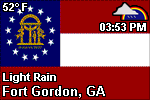Camp Gordon
 Camp Gordon, almost deserted after June 1948, came to life in September 1948 with the establishment of the Signal Corps Training Center. The post's training mission grew with the addition of the Military Police School in September 1948 and the activation of the Engineer Aviation Unit Training Center in January 1949 (the latter remained at Camp Gordon for only one year).
Camp Gordon, almost deserted after June 1948, came to life in September 1948 with the establishment of the Signal Corps Training Center. The post's training mission grew with the addition of the Military Police School in September 1948 and the activation of the Engineer Aviation Unit Training Center in January 1949 (the latter remained at Camp Gordon for only one year).
The Korean conflict again placed Camp Gordon center stage in preparing Soldiers for combat. In addition to communications personnel at the Signal Training Center's Signal Corps Replacement Training Center and Signal Unit Training Group, MPs trained for combat assignments while the 51st Anti-Aircraft Artillery Brigade formed three detachments before moving to Camp Stewart, Ga. In 1950, the installation became the site for Military Government Training for the Army.
Also during the decade, Camp Gordon was home to the only Army Criminal Investigation Laboratory in the continental United States as well as a Rehabilitation Training Center and a U.S. Disciplinary Barracks. In 1953, the Basic Replacement Training Center and the Advanced Leader's School provided basic training and advanced leadership training (both were inactivated in 1955). The Civil Affairs School arrived in 1955 as part of the Civil Affairs and Military Government School. Camp Gordon, becoming a permanent Army installation on March 21, 1956, was redesignated Fort Gordon.
The U.S. Army Training Center (Basic) was activated here in 1957. During the Vietnam War, infantry, military police and signal soldiers trained at Fort Gordon. While Signal Corps training continued to expand throughout the 1960s, other activities ceased through postwar deactivations and the Military Police School's move to Fort McClellan, Ala.
In June 1962, all activities of the Signal Corps Training Center were reorganized under the U.S. Army Southeastern Signal School. Designating the installation the U.S. Army Signal Center and Fort Gordon, the Army consolidated all communications training at Fort Gordon on Oct. 1, 1974. The arrival of the Army's Computer Science School was only part of the impetus for the fort's tremendous growth during the 1980s.
The following decade found its Mobilization Command deploying numerous troops to Southwest Asia during Operation Desert Shield-Desert Storm (1990-1991). Fort Gordon figures prominently in the post-Cold War national defense. Still the "Home of the Signal Regiment," it also supports the 35th Signal Brigade, 513th Military Intelligence Brigade, the National Security Agency/Central Security Service Georgia and the 7th Signal Command (Theater).


 Fort Gordon Garrison History
Fort Gordon Garrison History